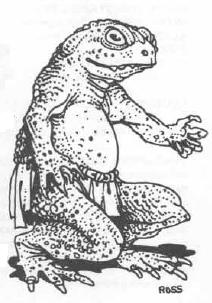
The slaad is a fictional monster in the Dungeons & Dragons fantasy role-playing game. They are extraplanar creatures (outsiders) that resemble giant humanoid toads of various colors, and other types, such as mud, and death slaadi.
Mystra is a fictional goddess in the Forgotten Realms campaign setting for the Dungeons & Dragons fantasy role-playing game.

The planes of the Dungeons & Dragons roleplaying game constitute the multiverse in which the game takes place. Each plane is a universe with its own rules with regard to gravity, geography, magic and morality. There have been various official cosmologies over the course of the different editions of the game; these cosmologies describe the structure of the standard Dungeons & Dragons multiverse.
The magic in Dungeons & Dragons consists of the spells and magic systems used in the settings of the role-playing game Dungeons & Dragons (D&D). D&D defined the genre of fantasy role-playing games, and remains the most popular table-top version. Many of the original concepts have become widely used in the role-playing community across many different fictional worlds, as well as across all manner of popular media including books, board games, video games, and films.

Chaos: The Battle of Wizards is a turn-based tactics video game released for the ZX Spectrum in 1985. It was written by Julian Gollop and originally published by Games Workshop. Based on Gollop's 1982 design for a board game / card game hybrid, Chaos received a positive reception and went on to influence various games, including Darwinia and King's Bounty, and spawned a sequel, Lords of Chaos, in 1990.
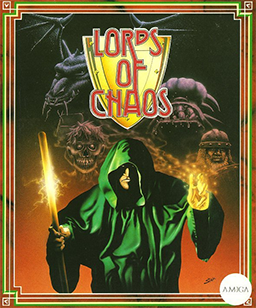
Lords of Chaos is a turn-based tactics tactical role-playing game published by Blade Software in 1990. It is the sequel to Chaos and an ancestor of the popular X-COM series of games, also written by Julian Gollop. In Lords of Chaos each player controls a wizard who can cast various magic spells. The spells have various effects, for example summoning other creatures, or damaging opposing creatures and wizards. The game can be played against a computer-controlled opponent or by up to four human players.
GrailQuest is a series of gamebooks by J. H. Brennan. The books are illustrated by John Higgins. The stories follow the adventures of a young hero named Pip, who is often called upon by Merlin to right wrongs and save the realm from evil. The series is light in tone and does not take itself seriously, often spoofing the fantasy genre and inserting slapstick humour or nonsensical elements.
Julian Gollop is a British video game designer and producer specialising in strategy games, who has founded and led Mythos Games, Codo Technologies and Snapshot Games. He is known best as the "man who gave birth to the X-COM franchise."
Onslaught is a Magic: The Gathering expert-level block. It consists of the expansion sets Onslaught, Legions and Scourge. The block's main theme is creature types, and much of the game play concerns interactions between these "tribes". The story continues the saga of the Mirari from the previous block of expansion sets. Onslaught was the last block printed before the "modern" card face style was introduced.
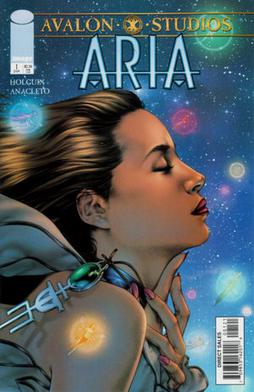
Aria is a comic book metaseries published by Image Comics, written by Brian Holguin and drawn by Jay Anacleto.
The flexibility of the Dungeons & Dragons (D&D) game rules means that Dungeon Masters (DM) are free to create their own fantasy campaign settings. For those who wanted a pre-packaged setting in which to play, TSR, Wizards of the Coast (WotC), and other publishers have created many settings in which D&D games can be based; of these, the Forgotten Realms, an epic fantasy world, has been one of the most successful and critically acclaimed settings. Many campaign settings include standard sword and sorcery environments, while others borrow Asian, Central American, swashbuckling, horror and even space-travel themes.
Kamigawa is an expert-level block for the Magic: The Gathering game inspired by Japanese myths and revolving around the battle between spirits (kami) and living beings. It consists of the expansion sets Champions of Kamigawa, Betrayers of Kamigawa, Saviors of Kamigawa, and Kamigawa: Neon Dynasty.
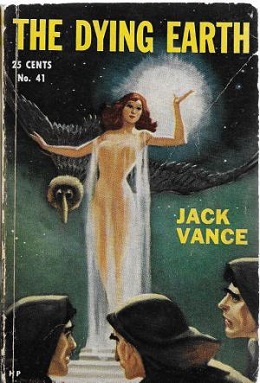
The Dying Earth is a collection of science fantasy/fantasy short fiction by American writer Jack Vance, published by Hillman in 1950. Vance returned to the setting in 1965 and thereafter, making it the first book in the Dying Earth series. It was retitled Mazirian the Magician in the Vance Integral Edition (2005), according to Jack Vance's expressed preference.
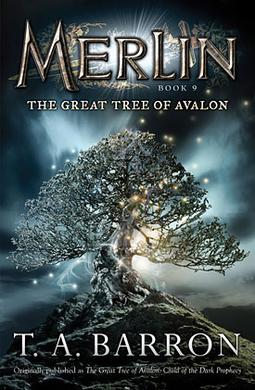
The Great Tree of Avalon is a fantasy novel by T. A. Barron, published by Penguin Young Readers Group. The book is the ninth novel in the 12-book series known as Merlin Saga. It was originally published as The Great Tree of Avalon: Child of the Dark Prophecy, the first novel in The Great Tree of Avalon trilogy, and is set in a world made up of a great tree and its seven roots inhabited by creatures.
Ravnica is a Magic: The Gathering block that consists of three expert-level expansion sets: Ravnica: City of Guilds, Guildpact, and Dissension. Following in the tradition of other Magic blocks, Ravnica takes place in a plane of the multiverse that was previously unexplored in the game's backstory. The world of Ravnica is an ecumenopolis, a vast city that covers the entire surface of its planet, and is home to a diverse assortment of sentient races. Much power in Ravnica is held by the ten "guilds", political factions that each represent a combination of two of Magic's five colors. The mythology of Ravnica is loosely derived from Slavic folklore, and the character names reflect this. This plane was revisited in the Return to Ravnica block, and the Guilds of Ravnica,Ravnica Allegiance, War of the Spark, and Murders at Karlov Manor sets.
The rules of Magic: The Gathering were originally developed by the game's creator, Richard Garfield, and accompanied the first version of the game in 1993. The rules of Magic have been changed frequently over the years by the manufacturer, Wizards of the Coast, mostly in minor ways. However, major rules overhauls have also been done a few times.

The Unholy Grail is a sword and sorcery novella by Fritz Leiber, recounting the earliest adventure of the Gray Mouser.
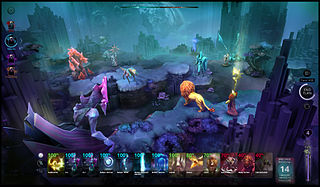
Chaos Reborn is a turn-based tactical role-playing game developed by Snapshot Games and was part funded through a Kickstarter crowdfunding campaign in April 2014. Following an early access release in December 2014, the full game was released in October 2015.
Dungeons & Dragons: Adventures in the Forgotten Realms is an expansion set for Magic: The Gathering (Magic) released in July 2021. The world of the Forgotten Realms was created by game designer Ed Greenwood around 1967 as a paracosm for his childhood stories and premiered as a campaign setting for the Dungeons & Dragons (D&D) fantasy role-playing game in the Forgotten Realms Campaign Setting (1987). This expansion set is the third collaboration between Magic and D&D; both teams are part of Wizards of the Coast.










